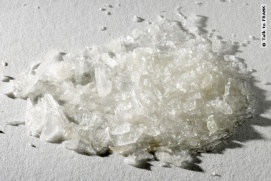Methamphetamine Abuse
Original Editors - Seth Pinkerton & Jessica Sparks from Bellarmine University's Pathophysiology of Complex Patient Problems project.
Lead Editors - Your name will be added here if you are a lead editor on this page. Read more.
Definition/Description[edit | edit source]
Methamphetamine is a central nervous system stimulant similar to the drug amphetamine and is classified as a Schedule II drug due to its high potential for abuse. It affects the brain by increasing the release and blocking the reuptake of dopamine which is a common mechanism of action for most drugs that are abused.[1]
Dopamine is a neurotransmitter responsible for the reward, motivation, and pleasure centers of the brain. Methamphetamine causes a rapid release of dopamine in the brain resulting in an intense euphoric or grandeur feeling which is the addictive property of the drug.[1]
Methamphetamine is a white, odorless, bitter tasting crystalline powder which can easily be dissolved in water or other liquids. It is taken orally, intranasally (snorting), by smoking, or intravenously.[1]
Meth can be made from common household substances including:
Pseudoephedrine - decongestant
iodine crystals
battery acid
red phosphorus – match boxes and road flares
anhydrous ammonia – fertilizer or countertop cleaner
toluene – brake fluid
hydrochloric acid
acetone – nail polish remover or paint thinner
sodium hydroxide - lye
sulfuric acid – drain or toilet bowl cleaner[3]
Street names include meth, speed, ice, glass, chalk, and many others.[1]
Prevalence[edit | edit source]
add text here
Characteristics/Clinical Presentation[edit | edit source]
Meth abusers can present with a variety of physical characteristics which can include the following:
- Increased heart rate, blood pressure, respiration, temperature
- Excessive sweating
- Dry skin with multiple scabs or open wounds on the face or arms
- Scratching or “picking” skin
- Track marks on arms or other parts of the body
- Rapid speech
- Anxiety
- Irritability
- Insomnia[4]
More chronic meth users can also present with the following:
- Anorexic appearance (extreme weight loss)
- “Meth mouth” – severe tooth loss/decay
- Confusion
- Hallucinations
- Paranoia
- Delusions of feeling bugs crawling under skin (which leads to excessive scratching and open wounds)
- Delusions of grandeur
- Violent behavior[4]
Associated Co-morbidities[edit | edit source]
add text here
Medications[edit | edit source]
There is no one drug that is used to cure methamphetamine addiction but this list offers help to those individuals who are in the process of recovering:
- Bupropion (Wellbutrin) - used to treat depression and cravings
- Topiramate (Topamax) –used to treat cravings and seizures that can occur during withdrawal
- Modafinil – non-amphetamine stimulant shown to improve cognitive functioning[5]
These drugs along with psychological treatment at a drug/rehab facility offer the best hope for the addict/abuser to have a successful recovery.[5]
Diagnostic Tests/Lab Tests/Lab Values[edit | edit source]
add text here
Etiology/Causes[edit | edit source]
There is not one known cause of methamphetamine abuse but it is thought that the following can lead someone to try meth and subsequently become addicted:
- Genetic predisposition (if a parent has an addiction problem it is thought that the child will be more likely to have an addiction problem as well)
- Risk seeking personality
- Peer pressure
- Low self-esteem
- Anxiety
- Loneliness or depression
- Ease to make
Systemic Involvement[edit | edit source]
add text here
Medical Management (current best evidence)[edit | edit source]
add text here
Physical Therapy Management (current best evidence)[edit | edit source]
add text here
Alternative/Holistic Management (current best evidence)[edit | edit source]
add text here
Differential Diagnosis[edit | edit source]
add text here
Case Reports/ Case Studies[edit | edit source]
add links to case studies here (case studies should be added on new pages using the case study template)
Resources
[edit | edit source]
Visit this website to find publicly funded treatment facilities in USA by state www.findtreatment.samhsa.gov
Centers for Disease Control and Prevention (CDC) http://www.cdc.gov/search.do?queryText=methamphetamine&action=search
Recent Related Research (from Pubmed)[edit | edit source]
see tutorial on Adding PubMed Feed
Failed to load RSS feed from http://eutils.ncbi.nlm.nih.gov/entrez/eutils/erss.cgi?rss_guid=1NGmwZeh8JwVIzrKgHG1LrDm0izTr7ViJiDkSYAY2BW5hiXsx0|charset=UTF-8|short|max=10: Error parsing XML for RSS
References[edit | edit source]
see adding references tutorial.
- ↑ 1.0 1.1 1.2 1.3 National Institute on Drug Abuse. http://www.drugabuse.gov/publications/infofacts/methamphetamine. (accessed 25 March 2012)
- ↑ Addiction Treatment Centers. Methamphetamine. http://www.addictiontreatmentcenters.net/about-the-drugs/methamphetamine (accessed 1 April 2012)
- ↑ Meth Project. What's in Meth. http://www.methproject.org/answers/whats-meth-made-of.html?gclid=CI3C--m7j68CFYMKKgodIkCUyQ#Whats-in-Meth (accessed 25 March 2012)
- ↑ 4.0 4.1 Mayo Clinic. Drug Addiction. http://www.mayoclinic.com/health/drug-addiction/DS00183/DSECTION=symptoms (accessed 26 March 2012)
- ↑ 5.0 5.1 Galanter M, Kleber H. The American Psychiatric Publishing Textbook of Substance Abuse Treatment. Fourth edition. Virginia: American Psychiatric Publishing, Inc., 2008. p169-176.







